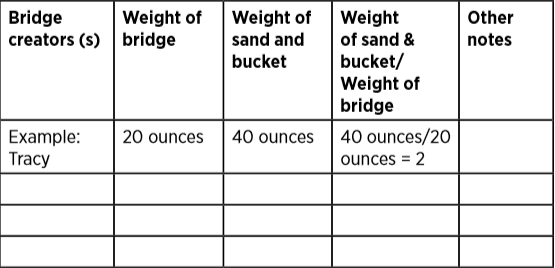
Bulletin 4H1750
Teaching science when you don't know diddly squat: Can you build a bridge out of pasta?
DOWNLOAD
June 18, 2019 - Michigan State University Extension
Purpose:
The purpose is not to teach specific content, but to teach the process of science – asking questions and discovering answers. This activity encourages young people to try to figure things out for themselves rather than just read an answer on the internet or in a book. As a leader, try not to express your opinion, but let the youth engage in arguments based on evidence.
Time required:
20 minutes or multiple days depending on the interest and questions the youth have. (It will also vary based on the time the glue takes to dry.)
Materials:
- Different sizes, shapes, and types of dried pasta (spaghetti, angel hair, linguini, lasagna, gluten-free, whole wheat, and others)
- Glue, such as hot glue, glue sticks, white glue (Feel free to experiment with different types, but be aware that drying time will affect the length of time to conduct the activity.
- Carabiner clip
- Pail with handle
- Scale
- Rope
- Sand
- 2 tables
Science Practice:
Asking questions and defining problems
1. There are many kinds of bridges: suspension bridges, railroad bridges, truss bridges, cantilever bridges, beam bridges. What kind of bridge is the best? Why do we have so many types of bridges? Are some better than others in certain situations?
Science Practice:
Developing and using models
2. How do engineers determine how much weight a bridge can hold? Do they drive trucks over it with increasing weight until the bridge collapses? Do you think you could build a model of a bridge and convert that to an actual size bridge?
Science Practice:
Planning and carrying out investigations
3. Have youth create a bridge out of pasta and glue. Explain to the youth that the bridges will need to support a carabiner clip and a pail. Weigh each bridge. Using the rope, suspend the bridge between two tables and have them attach the clip and pail to their bridge, and slowly fill the pail with sand until the bridge breaks. Then weigh the bucket and sand.
Science Practice:
Using mathematics and computational thinking:
4. Create a chart like the following:

Science Practice:
Analyzing and interpreting data
5. What bridges held the most weight? Why do you think that is? Do heavier bridges hold more weight? Why might that be important?
Science Practice:
Constructing explanations and designing solutions
6. What design is best for bridges? Are some bridges better for diferent situations? In the real world, would you want a light bridge that can support a lot of weight or a heavy bridge? Why? Do you think the amount of materials needed to make something has an impact in the real world? Would some bridge designs be better for pedestrians? What type of bridge would be better for freight trains? Would some be better for long spans compared to short spans?
Science Practice:
Engaging in argument from evidence
7. What do you think is the most important thing to consider when designing a bridge? The total weight it can support? The efficiency (construction cost compared to the weight it can hold) of the bridge? How will the bridge be used? Are there any ways to make this experiment more like the real world?
Other thoughts:
- Could you repeat this experiment with other materials?
- Consider testing different styles of bridges for their strength
- How are bridges used around the world?
- Do you think some materials might last longer in the real-world environment than others?
- How does the terrain affect the type of bridge you build? Would it be different if the supports were over water compared to on land? What if the different sides of the bridge were at different heights?
Science and Engineering practices:
These eight Science and Engineering Practices come from A Framework for K–12 Science Education (National Research Council, 2012, p. 42). These research-based best practices for engaging youth in science are connected to in-school science standards that all children must meet.
- Asking questions and defining problems
- Developing and using models
- Planning and carrying out investigations
- Analyzing and interpreting data
- Using mathematics and computational thinking
- Constructing explanations and designing solutions
- Engaging in argument from evidence
- Obtaining, evaluating, and communicating information
Reference:
National Research Council. (2012). A framework for K-12 science education: Practices, crosscutting concepts, and core ideas. Washington, DC: National Academies Press.



 Print
Print Email
Email
